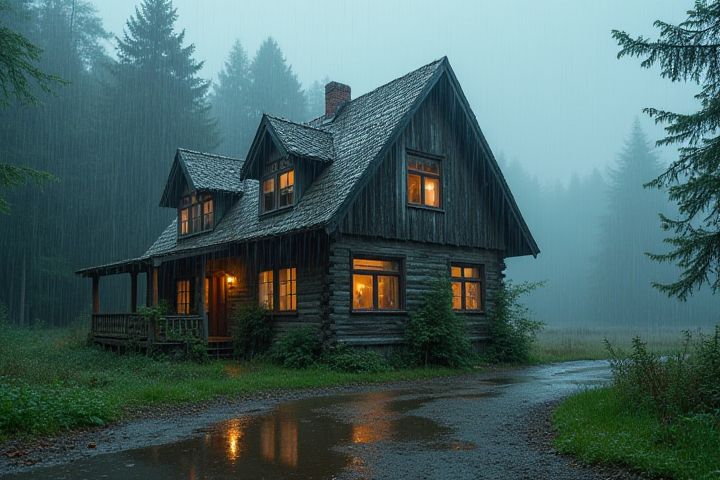
Painting a house in the rain is not advisable due to the impact of moisture on paint adhesion and drying times. Wet conditions can lead to streaks, peeling, and an uneven finish, ultimately compromising the quality of your paint job. Most professional painters recommend waiting until at least 24 hours after rainfall for surfaces to dry thoroughly before applying any paint. Additionally, high humidity can affect the curing process, making it difficult for the paint to adhere correctly. To ensure a durable and visually appealing result, always check the weather forecast and choose an optimal time for your exterior painting project.
Can We Paint A House In The Rain
Paint adhesion issues
Painting a house during rainy conditions can significantly impact paint adhesion, leading to uneven finishes and premature peeling. The moisture in the air can prevent the paint from properly bonding to the surface, compromising the durability of the coat. If you decide to proceed, be mindful that the surface should be dry and free from water droplets to enhance adhesion. For optimal results, wait for a dry period with low humidity levels before starting your painting project.
Longer drying times
Painting a house in the rain significantly extends the drying times of the paint, potentially leading to undesirable results such as smudging or peeling. Moisture in the air prevents the paint from adhering properly to the surface, often resulting in frequent touch-ups or complete reapplication. If you must paint during rainy weather, consider using a paint specifically formulated for high humidity conditions, as these products often contain additives to enhance drying. Ensure you monitor the weather closely, as intermittent rains can disrupt the drying process even after you've applied a coat of paint.
Potential for streaks and runs
Painting a house in the rain increases the risk of streaks and runs, which can significantly affect your paint's finish and longevity. Moisture can prevent the paint from adhering properly to surfaces, leading to bubbles or peeling over time. To ensure a smooth, even coat, it is best to wait for dry weather, ideally with temperatures above 50degF (10degC) and low humidity. If you must paint in less-than-ideal conditions, using high-quality paint designed for damp environments may help mitigate these issues.
Compromised finish quality
Painting a house in the rain can significantly compromise the finish quality, leading to issues such as uneven coverage and poor adhesion. Moisture on the surface can cause paint to bead up or run, preventing it from properly bonding to the substrate. As a result, the paint may begin to peel or blister shortly after drying, diminishing the longevity of your exterior. For the best results, always check the weather forecast and wait for dry conditions to ensure a smooth and durable finish.
Increased risk of mold and mildew
Painting a house in the rain significantly increases the risk of mold and mildew due to prolonged moisture exposure. Wet surfaces can interfere with paint adhesion, leading to peeling and bubbling as the moisture becomes trapped beneath the paint layer. Mold spores thrive in damp conditions, potentially compromising both the integrity of the paint job and the long-term health of your home. For optimal results and to protect your investment, it's essential to select a dry day for painting, ensuring that surfaces are properly prepped and free from moisture.
Difficulty in proper application
Painting a house in the rain presents significant challenges that can impact the quality and durability of the finish. Moisture can prevent proper adhesion of paint to surfaces, leading to peeling and blistering over time. Additionally, rain can cause the paint to run or drip, resulting in an uneven and unsightly appearance. To achieve the best results, it's essential to wait for dry weather conditions, ensuring that surfaces are clean, dry, and properly prepped for optimal application.
Risk of paint wash-off
Painting a house during rainy weather poses a significant risk of paint wash-off. When rainwater interacts with freshly applied paint, it can dilute the pigments and binders, leading to a patchy or uneven finish. The moisture can also prevent proper adhesion to surfaces, resulting in peeling or flaking over time. For optimal results, it's crucial to wait for dry conditions, ensuring the paint cures correctly and provides a durable, long-lasting finish for your home.
Surface moisture interference
Painting a house in the rain poses significant challenges due to surface moisture interference that can affect adhesion and finish quality. Rain can cause paint to slide off, leading to an uneven layer and increasing the likelihood of peeling or blistering. Furthermore, humidity can slow down the drying process, preventing the paint from curing properly and compromising its durability. To achieve optimal results, it's crucial to ensure that surfaces are completely dry and free from moisture before applying paint.
Poor paint durability
Painting a house during rainy weather significantly compromises paint durability, as moisture can prevent proper adhesion and result in peeling or blistering. The presence of rain increases humidity levels, which can alter the paint's drying process and weaken its bond to the surface. Inadequate drying time may lead to the development of mildew or mold, further diminishing the longevity of your paint job. To ensure lasting results, it's advisable to wait for dry conditions, allowing your choice of exterior paint to cure effectively and maintain its integrity.
Delayed project timeline
Painting a house in the rain can significantly delay your project timeline due to adverse weather conditions. Rain can lead to improper drying of paint, resulting in peeling or bubbling, which necessitates reapplication and further extends the time needed to complete the job. Moreover, moisture can hinder the adhesion of paint to surfaces, requiring preventative measures and additional preparations to ensure quality results. To maintain efficiency, it's crucial to monitor weather forecasts and schedule your project during dry periods, preventing potential setbacks in your timeline.
